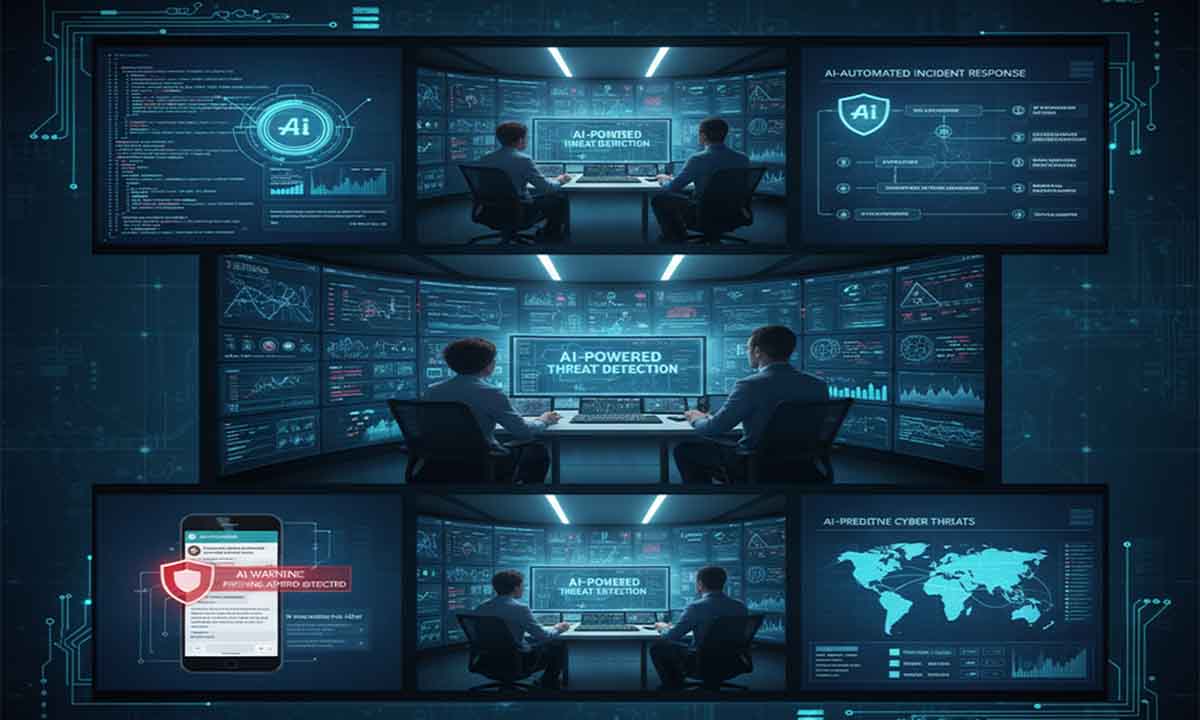
Protecting Our Digital World with Artificial Intelligence
Our lives today are deeply woven into the fabric of the internet. From purchasing daily necessities and connecting with loved ones on social media, to operating vast global enterprises, our existence is increasingly digital. This digital convenience, however, arrives with a constant threat from cyberattacks. Individuals, businesses, and even governments across the globe face ongoing risks of fraud, information theft, and various malicious activities online. Amidst this significant challenge, a groundbreaking solution offers considerable hope: Artificial Intelligence (AI). AI serves as an active partner in maintaining security within the digital world, particularly in cybersecurity monitoring. Protecting our digital interactions, sensitive data, and critical infrastructure has become a paramount concern for everyone involved in the digital economy.
The Crucial Role of AI in Cybersecurity
AI tools for cybersecurity monitoring provide substantial assistance in identifying and stopping threats. These systems analyze massive amounts of data with greater speed and effectiveness than any human can. Through continuous learning, AI identifies unusual patterns that may signal an attack, allowing for rapid response before a situation worsens. AI’s ability to automate processes also eases the burden on security teams, freeing them to focus on more intricate issues.
Implementing AI strengthens an organization’s defenses against various cyber threats, from phishing to advanced persistent threats. It offers peace of mind to users, assuring them their vital information remains protected. Businesses also benefit from maintaining customer trust. AI’s contribution to cybersecurity marks a significant stride toward a safer digital future for everyone.
Understanding AI in Cybersecurity Threat Detection
Artificial Intelligence allows machines to think and learn similarly to humans. In cybersecurity, this means AI systems can examine the vast information flowing through a network. Imagine a large corporation with thousands of employees using the internet simultaneously. Every email sent, website visited, and file downloaded generates “data.” Manually reviewing all this activity for anything suspicious would be incredibly difficult for a person.
This is where AI becomes indispensable. AI tools train to identify a network’s “normal” behavior. When something deviates from this expected pattern for example, an employee suddenly downloads hundreds of sensitive files in the middle of the night, an action outside their usual routine the AI immediately issues an alert. This acts like a highly intelligent guard, constantly observing every movement and understanding what to monitor. It detects not only known threats but also new attack types previously unseen, thanks to its capacity for continuous learning and adaptation. AI’s ability to process and interpret vast data sets allows it to recognize subtle indicators of compromise that human analysts might miss. This proactive identification is vital for robust digital defenses against an ever-changing landscape of cyber threats.
Rapid Anomaly Identification
One of AI’s most important abilities in cybersecurity monitoring is its capacity to identify anomalies, or unusual occurrences. Consider a typical scenario: a European company generally experiences a consistent volume of data traffic flowing through its network. Suddenly, the AI system detects a significant increase in data transmitted from their server to an unknown location in Asia. For a human, noticing this change or comprehending its meaning might take considerable time. However, for AI, this shift immediately recognizes as a potential issue.
AI uses “machine learning” to analyze patterns. This works much like teaching a child to recognize different animals. After seeing numerous examples, the child can then identify an animal even if they have not seen that exact picture before. Similarly, AI trains on vast collections of both benign and malicious data. Consequently, it learns to distinguish even the slightest deviation from normal behavior, which often signals a cyberattack. Anomaly detection is extremely important because cybercriminals constantly change their methods. AI offers a dynamic defense against these evolving threats, ensuring even novel attack vectors are identified promptly. The speed and precision of AI in flagging unusual activities significantly reduce the window of opportunity for attackers, thereby reinforcing overall network security.
Strengthening Detection Against Malware and Phishing
Malware and phishing represent two of the most common and destructive cyberattacks globally. Malware includes any program designed to harm a computer system, such as viruses, ransomware, and spyware. Phishing, in contrast, involves deceiving individuals into providing sensitive information, like passwords or credit card details, by impersonating a trustworthy entity, typically through email.
AI employs advanced algorithms to combat these pervasive threats. For malware, AI analyzes the code of a new program or file. Rather than relying solely on a constantly growing list of known malware signatures, AI observes the “behavior” of the code. If a file suddenly begins performing actions commonly associated with malware for example, attempting to modify critical system files or connect to suspicious servers the AI can immediately flag it as a threat. This method allows for the detection and blocking of even novel types of malware.
When it comes to phishing, AI’s strategy is refined. It examines thousands of email and looks at various attributes: the sender’s name, email subject, content, embedded links, and even grammatical errors. For instance, if an email originates from an unfamiliar address but pretends to be a well-known bank, and contains a link requesting personal information, AI can swiftly identify it as a phishing attempt. Some AI systems also analyze email context, making them more effective at catching sophisticated phishing scams that humans might struggle to detect. This provides an additional layer of protection for millions of email users worldwide, significantly reducing data breaches and financial fraud.
Streamlining Security with Automated Incident Response
Effective cybersecurity defense involves not only identifying threats but also responding to them quickly. In traditional methods, a security analyst manually examines the situation, pinpoints the origin, and then takes steps to stop the threat from spreading. This can be time-consuming and complex, giving attackers more time to inflict damage.
This is where AI plays a significant role through automated incident response. The moment AI identifies a threat, it can automatically initiate preliminary steps to prevent its spread. For instance, if suspicious activity originates from a particular device on the network, AI can automatically isolate that device. If an email containing malware is detected, AI can immediately remove it from all employee inboxes before anyone can open it.
Consider a multinational corporation. With AI, upon detecting an attempt to steal information from a server at their branch in South America, the AI immediately restricts access to the server for all unauthorized users and sends an alert to the security team. This rapid response is critical to prevent extensive damage and maintain continuous operations. AI’s automation not only reduces the workload on human security personnel but also speeds up the response process, resulting in improved global security. This immediate action drastically minimizes potential harm, safeguards vital assets, and ensures business continuity across diverse geographical locations.
Predictive Analytics and Proactive Defense
A major advantage of AI is its ability to not only identify current threats but also to anticipate possible future threats. This capability is known as “predictive analytics.” AI utilizes historical cyberattack data, combined with current security trends, to determine where the next attack might originate or what type of attack cybercriminals might employ.
For instance, if AI detects a sudden increase in “zero-day exploits” (threats previously unknown and without available defenses) occurring in a particular global sector, it can alert companies to strengthen their defenses in specific parts of their systems. AI can also recommend changes to network configurations or software upgrades to close potential security gaps before attackers can exploit them. This forward-looking approach helps organizations harden their systems against emerging threats.
This acts like having a security expert always a step ahead of criminals. By anticipating where problems might arise, organizations can adopt a proactive stance rather than a reactive one. This grants them the opportunity to fortify their defenses and prepare before a threat strikes. This level of proactive defense is essential for critical infrastructure, financial institutions, and government entities, which are consistently targets of sophisticated cyberattacks. AI-driven predictive models continuously learn from new vulnerabilities and attack methods, creating a dynamic shield that adapts faster than traditional security measures.
Protecting Data and Confirming Identity
In our digital world, personal information holds immense value. Everything from our names and addresses to our financial details can be at risk if not properly protected. AI uses various methods to ensure data security and verify the authenticity of user identities.
For data protection, AI monitors the flow of sensitive information both within and outside a network. If an unauthorized attempt to exfiltrate data is detected, AI can immediately prevent it. For example, if an employee suddenly tries to copy thousands of customer records to a USB drive, an action outside their usual job function, AI can block that action and alert the security team. This is particularly vital for companies managing millions of customer data points across different countries, ensuring compliance with global data protection regulations and preventing massive data breaches.
When it comes to confirming identity, AI plays a crucial role in “multi-factor authentication” (MFA) and “behavioral biometrics.” MFA requires more than one method to prove your identity, such as a password and a code sent to your phone. AI makes this process smarter by learning your typical behavior. For instance, if you consistently log in from your home computer at a specific time, and then a login attempt suddenly appears from an unknown location on a different continent at an unusual hour, AI might request additional proof of identity before allowing access.
Behavioral biometrics uses AI to analyze your unique typing patterns, mouse movements, or even how you hold your phone. If a user’s behavior suddenly changes, it could signal that the legitimate user is not the one using the account. This makes it significantly harder for cybercriminals to impersonate a user even if they have obtained the password. These advanced methods provide a robust defense against identity theft and unauthorized access to important accounts, thereby safeguarding individuals and organizations worldwide from the severe consequences of compromised credentials.
Challenges and the Future of AI in Cybersecurity
While AI significantly contributes to cybersecurity, its implementation still faces certain challenges. One obstacle is “adversarial AI.” This occurs when cybercriminals attempt to deceive AI systems by creating data that appears normal but contains malicious intent. The continuous struggle between AI defenses and adversarial AI remains an ever-changing aspect of digital security, requiring constant adaptation and innovation.
Another challenge involves the need for vast quantities of high-quality data to train AI systems effectively. For AI to be proficient, it must learn from a diverse range of both benign and malicious data. There is also the issue of “false positives,” where AI issues a warning for something not actually a threat. Balancing sensitivity to threats with minimizing false alarms is a critical ongoing effort. Understanding the foundational principles of Artificial Intelligence and its diverse applications in modern computing is crucial for navigating this evolving landscape.
Despite these hurdles, the future of AI in cybersecurity looks very promising. Technology continues to advance, and as AI’s capacity to learn and adapt expands, it will become even more effective at protecting us. We can anticipate enhanced predictive capabilities, quicker automated responses, and more intelligent methods for detecting previously unseen threats. The collaboration between humans and AI will be key to creating a more resilient and secure digital environment for all users in every corner of the world. This synergy promises a future where AI handles routine and complex threat identification, allowing human experts to focus on strategic defense planning and intricate problem-solving.
The application of Artificial Intelligence in cybersecurity monitoring stands as a vital partner in maintaining a secure digital world. It empowers organizations and individuals to defend themselves against constantly changing threats, enabling them to confidently use the benefits of the digital economy with greater peace of mind. By automating complex security tasks and providing predictive capabilities, AI ensures a safer online experience for everyone, everywhere.


No Comments